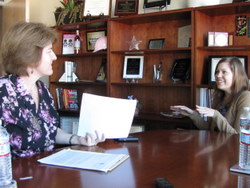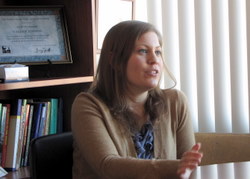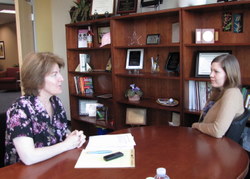Celebrating the passion, dedication and personal stories of Social Ecology faculty, staff, students, alumni and benefactors, “The Dean Asks…” is a feature in which Dean Valerie Jenness interviews people inspired by the pursuit of excellence and encourages participation in interdisciplinary education to solve complex societal problems. Over the next year, please check back to read or listen to additional installments. View Archive
 Compassionate release, medical parole, humanitarian parole…all terms used to describe the releasing of terminally ill or medically incapacitated prisoners. What are the consequences of this correctional practice and how it is implemented? California is at a historical moment in which prison overcrowding, fiscal strife and political warfare over correctional policy make understanding this policy and attendant practice a must. Valerie Jenness, Dean of the School of Social Ecology, interviewed graduate student Ashley Demyan about her current research on this controversial topic.
Compassionate release, medical parole, humanitarian parole…all terms used to describe the releasing of terminally ill or medically incapacitated prisoners. What are the consequences of this correctional practice and how it is implemented? California is at a historical moment in which prison overcrowding, fiscal strife and political warfare over correctional policy make understanding this policy and attendant practice a must. Valerie Jenness, Dean of the School of Social Ecology, interviewed graduate student Ashley Demyan about her current research on this controversial topic.
Val: Can you give us a sense of what medical release is and how it works in the criminal justice system?
Ashley: I use the term medical release to capture all of the terms of compassionate release, medical parole, humanitarian parole - they all share the same endpoint of releasing terminally ill or medically incapacitated prisoners so they’re no longer being treated within the prison. The sickest inmates are costing two to three times more than regular inmates. With the skyrocketing aging populations and more people being sick in prison, this is a way for the correctional officials to get those people out. Eligible prisoners are either terminally ill, meaning death is expected within six to twelve months, or permanently physically incapacitated, which means that they can’t perform activities of daily living, including breathing, eating, or using the restroom. They basically seem to no longer be a threat to public safety so we can release them and their likelihood of reoffending is lessened.
 Val: Can you help us understand why people would want to do this and why people would be opposed to enacting this policy more frequently?
Val: Can you help us understand why people would want to do this and why people would be opposed to enacting this policy more frequently?
Ashley: In terms of wanting to do this, it does save money. When you release a prisoner he still needs treatment. The state is still paying for their care, except their care is no longer coming out of the correction's budget. It shifts the money away from the correction's budget and they are eligible for federal aid, which takes some of the cost away from the state. For example, in the Susan Atkins case, she was costing taxpayers 1.5 million dollars in a four month period, including over $300,000 in guard costs, because she had to be guarded by two guards around the clock in her hospital bed. Those costs are eliminated.
Val: You often cite the Susan Atkins case in your work. Could you give an overview of how Susan Atkins became an iconic case for discussion of what was then called compassionate release?
Ashley: Susan was a member of Charlie Manson’s cult. She was twenty-one at the time and she went to Sharon Tate’s house, the actress, who was eight months pregnant with Roman Polanski’s child. She and fellow cult members went in and they murdered everyone. She was the one who stood over Sharon Tate and stabbed her to death while she begged for the life of her unborn child. She is seen as the worst of them all. She went on trial, gets convicted, and then ends up being the longest serving woman in California prison history. In prison she found God and reformed and became a model inmate, a born again Christian. She was diagnosed with cancer. In 2008 when she applied for compassionate release she was missing one leg, she was paralyzed on one side of her body, she was immobile. It was denied. I think that there are three interesting things about this. One is that it is called compassionate release and here’s this person asking for compassionate release when she committed one of the most recognizable crimes in California history.
Val: One of the last interviews with Susan Atkins was with Diane Sawyer. She asks Susan Atkins, who is near the end of her life, what do you say to people who say you gave no mercy and now you want mercy?
Ashley: Right. How is the parole board going to say okay, yes, you deserve to die free. The second reason why it is an interesting case is that Susan should have never gotten to the parole board in the first place. In the law, one of the considerations for going forward with these cases is whether or not it’s a high notoriety case because obviously it’s going to generate media outcry and it did. That’s the only reason I learned about all this is because of her case. The third interesting fact of compassionate release is that one of the criteria for a terminal illness is that death is expected within, I think at that point it was six months, and she lasted fifteen months more. This was in June 2008 and she didn’t die until September 2009. It shows the uncertainty of death.
 Val: Can you give us some numbers because you have in your own work a lot of numbers you throw around?
Val: Can you give us some numbers because you have in your own work a lot of numbers you throw around?
Ashley: I’m hesitant to talk about aging because this policy affects more than just aging, but aging prisoners are a growing concern. Aging prisoners in California are skyrocketing. I think the numbers increased thirty percent in two years. Aging prisoners cost between two and three times more and they are taking a huge chunk of the prison healthcare budget. The prison healthcare budget is 2.5 billion. In 2010 I think that there are thirteen thousand and some that the CDCR classifies as elderly, aging, above fifty five. They are more at risk for these illnesses.
Val: From 1991 to 2008, 948 prisoners applied for compassionate release in California; and of those, 289, thirty percent, were granted release by the sentencing courts, which is the final stage. We’re not talking about a lot of people at the end of the day. Why should we make note of this policy?
Ashley: One of the reasons that I am studying this is to find out why it isn’t used more since it is a policy that will remove the costliest inmates.
Val: Let's discuss the Martinez case that appeared in the L.A. Times – “California authorities deny state medical parole case.” This was the first case coming in under medical parole. A quadriplegic inmate serving a 150 year term applies for medical release and doesn’t get it. Why not?
Ashley: California has two policies-compassionate release is for terminally ill or incapacitated prisoners. Death has to be expected within six months. They go through a process that ends at the sentencing court. Their case goes all the way back to their original sentencing judge and then the sentencing judge essentially resentences them to time served and they are released. They’re not under the jurisdiction of CDCR anymore. If they get better, there is nothing that the state can do to return them to prison. Compassionate release is written in the penal code. Medical parole is a new law that was enacted in September of last year. It is only for physically incapacitated prisoners and they go up in front of a parole board just like any other parole hearing. If released, the inmate is still under the supervision of the CDCR. In regards to the Martinez case, first it was a terrible case to be the first medical parole case to be ruled on just because of crime details. To describe this as heinous would be correct. In terms of why he was denied, from what I understand, a lot of that was based on institutional behavior. Institutional behavior is largely what they use to determine whether or not someone’s going to re-offend.
Val: People running the institutions have to kind of look into the future and say “What do we think they are going to do?” and we don’t know. When it comes to this, are you eligible, how heinous was your crime? Do we think that he is going to be a model citizen, do we think that he is going to harm anybody in the community if we release him? It sure assumes a lot of confidence in our ability to look forward, doesn’t it?
Ashley: Which is a huge problem because this results in very few people being released. One of the reasons they denied Martinez was that his ability to still use his vocal cords was considered a matter of public safety.
 Val: What do you think are the main factors that shape the release decision?
Val: What do you think are the main factors that shape the release decision?
Ashley: I do not want this to come across as not giving consideration to the victims because that would be offensive. In this case there is a living victim. Maybe one of the most important factors in this is the victim’s input. Sometimes the victims have no opinion or will argue in favor of release. I think that is an important consideration that the board needs to consider. I think that a lot of weight is institutional behavior. Are they assertive, verbally assaultive to staff or are they respectful? Are they going to be a threat to other caregivers?
Val: When you talk to someone about this policy and what you are studying, what’s the common response you get?
Ashley: That would be what I said earlier; there wasn’t compassion shown when the crime was committed. I also think that the economic argument is compelling. When medical parole was being legislated, there were only 429 prisoners eligible for release under medical parole, which seems like nothing. Their combined medical bills I think were close to 50 million. Is there anyone in California that’s going to say the government doesn’t need that money?
Val: As a fellow criminologist, one of the things that I always find fascinating is what we call symbolic law and instrumental law. When I first began to get familiar with your work, I learned there are a lot of people eligible and they don’t all apply - so I thought that this was symbolic law. It’s never meant to really be used. Then the economy tanks so is this now instrumental law, a law that produces effects that you can capture empirically. Do you think this is symbolic law or instrumental law or a little of both?
Ashley: It’s a mix. Basically the compassionate releases started happening in the early ‘90s, the height of the AIDS epidemic. When it started it was for compassion because there were prisoners dying of AIDS and they were the large population that was being released under this. Once AIDS became a chronic condition, other prisoners started applying and then it kind of went into relative obscurity. But nothing ever came of it and that’s when medical parole attempted to be so much more and get results and things like that.
 Val: Prisons are kind of isolated places that most of the public doesn’t go to visit but instead just sees in the movies. Do you think that it would be different if our prisons were more publicly available and that those populations were more visible?
Val: Prisons are kind of isolated places that most of the public doesn’t go to visit but instead just sees in the movies. Do you think that it would be different if our prisons were more publicly available and that those populations were more visible?
Ashley: Absolutely. I spent five weeks doing an Inside/Out course. I assisted a professor and there were about ten outside students from Ohio University and ten inside students who were prisoners at a local prison. This prison was a geriatric facility.All the inside class members were fifty-five or older. We spent five weeks going to the prison twice a week and we would have classes there. We would walk through the prison with these aging offenders. It was so striking to see - they all had their medical issues and they were using walkers, had tracheotomy tubes and all these different things. We went on two tours of the prison - one with the C.O. and one with the prisoners. We got to see it through their eyes. These are people that faced the possibility of dying in prison.
Val: Let me give you a chance to tell us about personalizing this and humanizing this topic. What drew you to this research topic?
Ashley: I think that it was multiple things that drew me to this topic including doing research in prisons and watching people go up for parole hearings and being denied while I was completing my Master’s thesis. While I was completing my Master’s thesis, one of the participants was eligible for parole. If I could have vouched for him, I would have. In terms of who I felt would have been a successful parolee, he would have gone out and been fine. During the course of my research he went up in front before the parole board and I was feeling pretty hopeful, optimistic to watch him, and they gave him five more years. That was one that was hard watching because I kept thinking I’ve changed so much in the seven weeks that I’ve been doing this research and here is this man that has been here for twenty years and he was, by all accounts, a model inmate.
Val: This reminds me of something that you said earlier. By your own account, you strike me as a compassionate person. Do you also get exposure to and have the same humanizing effect with victims, with communities? One of the things that happens, in my experience, is we study groups of people and we come to know them, they are human, you care about them, but sometimes we do that to the exclusion of other groups.
Ashley: The victims are always in the back of my mind because I don’t want to say the criminal deserves to be released, because that is not fair. That crime didn’t happen to me.
Val: If people listen to this, what’s the one thing you would hope people would think about on this complicated issue?
Ashley: I think that the most important thing that I can see coming from this is just knowledge because before I started this, there was nothing. It was three months of hard work before I even understood - before I got the process right. It wasn’t until I spoke with someone within the CDCR that had written the medical parole law that I understood what was going on. I would like to go state-by-state and compile a guide of policies and distribute it to the prisoners and prisoners’ families because there isn’t any information. You just hear compassionate release and you think it’s great or it’s terrible, but I want people to understand how it works, why it came about and why it is or isn’t a good policy.